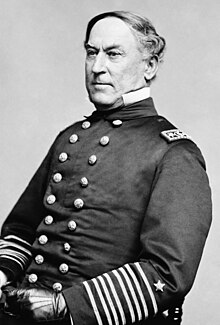David G. Farragut
| David Farragut | |
|---|---|
 |
|
| Birth name | James Glasgow Farragut |
| Born |
July 5, 1801 Campbell's Station, Tennessee U.S. (now Farragut, Tennessee, U.S.) |
| Died | August 14, 1870 (aged 69) Portsmouth, New Hampshire, U.S. (now Kittery, Maine, U.S.) |
| Buried at | Woodlawn Cemetery, the Bronx |
| Allegiance |
United States of America Union |
| Service/branch |
United States Navy Union Navy |
| Years of service | 1810–1870 |
| Rank |
|
| Commands held |
USS Ferret USS Saratoga USS Brooklyn Mare Island Navy Yard European Squadron Western Gulf Blockading Squadron |
| Battles/wars |
West Indies anti-piracy operations |
| Signature | |
West Indies anti-piracy operations
Mexican–American War
American Civil War
David Glasgow Farragut /ˈfærəɡət/ (also spelled Glascoe; July 5, 1801 – August 14, 1870) was a flag officer of the United States Navy during the American Civil War. He was the first rear admiral, vice admiral, and admiral in the United States Navy. He is remembered for his order at the Battle of Mobile Bay (in which he was victorious) usually paraphrased as "Damn the torpedoes, full speed ahead" in U.S. Navy tradition.
Farragut was born in 1801 to Jordi (George) Farragut, a native of Minorca, Spain, and his wife Elizabeth (née Shine, 1765–1808), of North Carolina Scots-Irish American descent, at Lowe's Ferry on the Holston River in Tennessee. It was a few miles southeast of Campbell's Station, near Knoxville.
His father operated the ferry and also served as a cavalry officer in the Tennessee militia. Jordi Farragut, son of Antoni Farragut and Joana Mesquida, became a Spanish merchant captain from Minorca. He joined the American Revolutionary cause after arriving in America in 1766, when he changed his first name to George. He was a naval lieutenant during the Revolutionary War, serving first with the South Carolina Navy then the Continental Naval forces. George and Elizabeth had moved west to Tennessee after his service in the American Revolution.
...
Wikipedia
